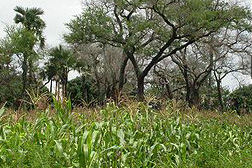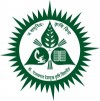|
|
 |
||
|
|
|||
|
|
|||
|
|
|||
|
|
Scientists |
||
|
|
|||
|
|
|||
|
|
About Project
All India Co-ordinated Research Project on Agroforestry (AICRP on Agroforestry) is one of the co-ordinating centre of ICAR. The implementation of this project at College of Agriculture, Nagpur under Dr. Panjabrao Deshmukh Krishi Vidyapeeth, Akola (M.S.) started in February1991. The project was sanctioned on 75:25 basis to be shared by ICAR and State Government respectively. The project was initiated with the objectives of popularization of Agroforestry in the region. The futala developmental unit have been merged in AICRP on agroforestry and the reorganized unit is renamed as Agroforestry Research Farm, College of Agriculture, Nagpur.
Infrastructure
Land available and area under different Trees and Fruit Crops
|
Tree / Fruit Species
|
Area (Ha) | Remarks |
|---|---|---|
| Teak | 6.50 | Field evaluation trials, Agrisilviculture, spacing trials, management practices trial,SWC experiment |
| Shivan | 1.20 | Agrisilviculture |
| Maharukh | 1.75 | Agrisilviculture, Progeny evaluation trials |
| Jatropha | 1.50 | Germplasm collection and evaluation |
| Nilgiri | 0.50 | Clonal evaluation trial |
| Sisoo | 0.50 | SWC experiment |
| Bamboo | 4.50 | Field evaluation trials, management practices trial |
| Aonla | 1.00 | Hortipastoral system,SWC experment |
| Nagpur Mandrin | 3.00 | Orchard |
| Lemon | 1.50 | Orchard |
| Sweet orange | 1.50 | Orchard |
| Field crops | 7.50 | Forage, etc. |
| Fallow land | 3.025 | Depth varying from 30 to 45cm |
| Uncultivable land | 12.80 | Rocky, unduting,excavated patches |
| Scrub forest | 73.00 | Varying density |
Mandate
-
Diagnostic Survey and appraisal of existing farming systems and Agroforestry practices.
-
Research related to basic and applied aspects including development of appropriate methodologies for Agroforestry Systems.
-
To develop various Agroforestry systems.
Objectives
-
Collection, screening and selection of promising germplasm indigenous as well as exotic species from different ecological regions.
-
Developing different Agri-silvicultural, Agri- horticultural and Silvipastoral technique acceptable to local population.
-
Developing sequential systems of inter cropping.
-
Evolving the economics of different Agroforestry systems and establishing it’s co-relation with management Viz. conservation,development and utilization.
Projects Operating at Station
- Performance and evaluation ofdifferent MPTS under Agri-Silviculture.
- Studies on integrated nutrient management of Teak.
- Compatibility studies of different trees and crops.
- Preparation of vermicompost using biomass from Teak based Agroforestry system.
- Studies on organic manuring in Jatropha curcas.
- Effect of pruning on Jatropha curcas
- Field evaluation trial of teak
- Studies on irrigation requirement of Teak
- Effect of contour trenching on in-situ water conservation and growth of crops in hortipastoral system.
- To study the effect of conservation practices and felling intensity on production of Bamboo.
- Standardization of vegetative Propogation Techniques in Bamboo(D.strictus)
- Evaluation of crops for intercropping in bamboo based Agri-silviculture system.
- Standardization of technique for developingtall seedling of teak
- Development of quality planting material of Bamboo (D.strictus)
Research Activities / Achievements/ Recommendations
Recommendation–
Application of fifty kg nitrogen/ha is recommended for maximum production of bamboo.
In Teak and black gram based agroforestry system, planting of teak at 8X 2m spacing is recommended.
Recommendation
Maharukh (Ailanthus excelsa) is recommended for cultivation in agroforesrtry.
Construction of Gabion check dam with clay blanketing for storage of runoff and loose rock check dams for control of gully erosion are recommended.
Reccomendation
In Agroforestry, for maximum wood production in Teak establishment of narrow base contour bunds along with vegetative barrier at horizontal interval of 30 m is recommended.
Reccomendation
For maximum timber production on ill drained soils, planting of Sissoo can be recommended at 40 to 60 cm isobath.
For the afforestation of waste land in Vidarbha region through agroforestry system and for higher economic benefits planting of teak at 8 X 2 meter spacing along with black gram as intercrop and thinning of alternate tree in row (girth 25-30 cm) at age of seven year is recommended.
Transfer of Technologies
Progressive cultivators from the villages have been adopted for agroforestry system
| Sr. No. | Village & Dist. | Agroforestry system | Area (Ha) |
|---|---|---|---|
| 1 | Nilaj ,Bhandara | Rice +Teak Rice +Gmelina Rice +Eucalyptus Rice +Mango |
3.00 |
| 2. | Nandgaon, Amravati | Sweet orange +Teak N. Mandrin +Teak Teak + Soyabeen |
5.00 |
| 3. | Seloo, Wardha | Teak+Termeric | 3.00 |
| 4. | Bajargaon, Nagpur | Aonla+Teak+Gram+Pigeon pea Mango +Soybean +cow pea. |
4.50 |
| 5. | Warud, Amravati | Citrus+Soyabean+Teak | 12.00 |
|
6. |
Belati, Bhandara | Rice+Teak+Mango | 4.00 |
| 7. | Talodi (Balapur), Chandrapur | Teak+Rice, Bamboo+Rice | 6.00 |
| 8. | 17th mile, Nagpur | Teak+Vermcompost Teak+Floriculture |
3.00 |
| 9. | Pimpalgaon, Bhandara | Rice+Bamboo Rice +Teak |
2.50 |
| 10. | Shenda., Gondiya | Teak +Rice+Pigeon pea | 3.50 |
Contact Information
Sr. Scientist & Officer in Charge
AICRP on Agroforestry
College of Agriculture, Nagpur
